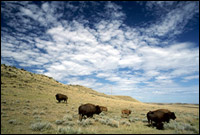Dear Umbra,
I liked your column about homemade cleaning products. I have a question, though: What’s up with baking soda? It’s frequently bandied about as an eco-friendly cleaner, but I have no idea what it is, where it comes from, or how it’s made.
Amanda
Charlottesville, Va.
Dearest Amanda,
Baking soda is sodium bicarbonate, a naturally occurring crystalline compound. I can be unusually precise about where it comes from: Green River, Wyo.

Wyoming: what lies beneath?
Photo: USDA.
Turns out Wyoming holds the world’s largest reserves of trona, otherwise known as sodium sesquicarbonate — a key ingredient in your mysterious household staple. An estimated 100 billion tons or more sit right there under the high-steppe desert. Almost all baking soda made in the U.S. comes from there, and a quarter of the world’s supply too.
Trona room-and-pillar mining — picture miners standing in a sort of underground city — is a mainstay of the Sweetwater County economy, employing more than 2,000 Wyomingites. The ore is removed with boring equipment, then processed into soda ash. The ash — which can also be used to make glass, bread, and paper — is dissolved in water and bubbled with carbon dioxide, forming sodium-bicarbonate crystals. The crystals are harvested by little gnomes and packaged for delivery to a grocery store near you.
Here, because I know you are wondering, is the most pressing environmental concern I have found associated with trona mining: the wastewater is very salty, and when it is piped away to a holding pond, it can make the birds that visit said pond fall sick, and sometimes drown. I will let you decide for yourself whether this scourge is worth fretting about.
Now, as for the cleanser bandying, we can chalk that up to the magic of crystal alkalinity. Our messes and stinks often have an acidic component: there are fatty acids in grease and dirt, and unpleasant smells like sour milk have acidic sources. Chemically basic baking soda neutralizes these acids, which is why the smell goes away. It’s also a crystal, so it scrubs, but is soft and dissolves in water, so it doesn’t scratch. It’s amply present in our environment and our bodies to begin with, and appears to be nontoxic (although it should be kept away from the little ones). We use it for leavening and eat it. It is basically yummier dirt.
Baking powder, by contrast, combines baking soda (a base) and cream of tartar (an acid), which react together when moistened and produce carbon-dioxide bubbles. It’s not so effective for cleaning, since it doesn’t cancel out acid and doesn’t scrub well. But it sure comes in handy when we whip up our famous Grist biscuits.
Bakily,
Umbra


